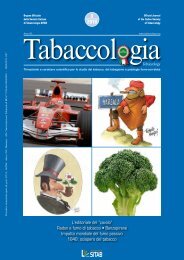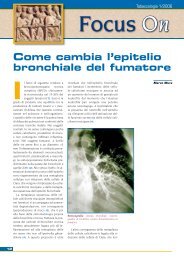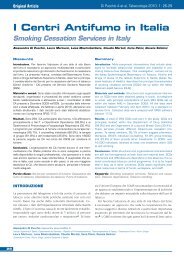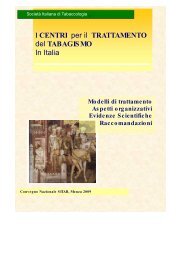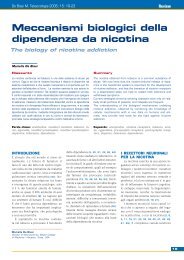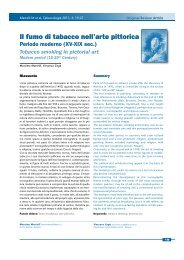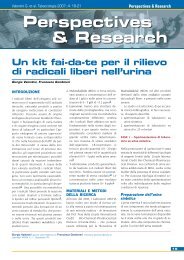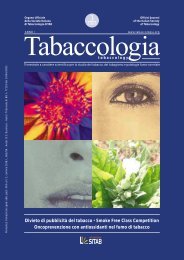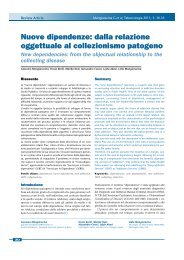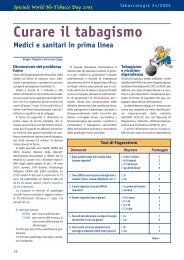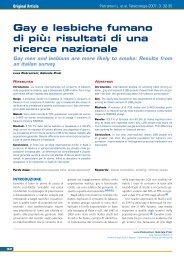Scarica n. 1/2011 - Società Italiana di Tabaccologia
Scarica n. 1/2011 - Società Italiana di Tabaccologia
Scarica n. 1/2011 - Società Italiana di Tabaccologia
Create successful ePaper yourself
Turn your PDF publications into a flip-book with our unique Google optimized e-Paper software.
20<br />
Original Article Research<br />
zata da perio<strong>di</strong> <strong>di</strong> interesse da parte della scienza ufficiale,<br />
evidenziati da serie <strong>di</strong> pubblicazioni e <strong>di</strong>scussioni sull’argomento,<br />
alternati ad anni <strong>di</strong> silenzio. L’industria del tabacco<br />
alla fine si abituò a questi perio<strong>di</strong> <strong>di</strong> interesse per<br />
l’argomento, e il suo silenzio ufficiale, purtroppo, fu in<br />
parte ispirato da questo andamento.<br />
Durante la fine degli anni 70 e l’inizio degli ‘80, una notevole<br />
quantità <strong>di</strong> documenti della Philip Morris (PM) documentano<br />
un <strong>di</strong>battito interno tra scienziati e funzionari<br />
sulla necessità o meno <strong>di</strong> pubblicare le proprie ricerche.<br />
All’epoca, ci fu un periodo <strong>di</strong> calma nelle pubblicazioni<br />
esterne, una tregua che l’Azienda sperò durasse il più a<br />
lungo possibile. Gli addetti al tabacco non volevano <strong>di</strong>sturbare<br />
la relativa quiete esterna sull’argomento pubblicando<br />
le proprie ricerche, il che avrebbe stimolato un’ondata<br />
<strong>di</strong> nuovi stu<strong>di</strong> e documenti.<br />
Nel 1977, gli scienziati della PM completarono la stesura<br />
<strong>di</strong> un documento intitolato “Prodotti <strong>di</strong> degradazione del<br />
Radon-222 naturalmente presenti nel tabacco e nel condensato<br />
del fumo”, che gli Autori avrebbero voluto presentare<br />
a Science. Se il lavoro fosse stato pubblicato, la PM<br />
avrebbe rivelato il livello della propria attività <strong>di</strong> ricerca<br />
sul polonio, cosicché il documento fu mandato alla Direzione<br />
per la revisione e l’autorizzazione necessaria. Pochi<br />
mesi dopo, le opinioni erano chiaramente <strong>di</strong>vise, in quanto<br />
la pubblicazione dei dati avrebbe <strong>di</strong>mostrato l’attività<br />
<strong>di</strong> ricerca dell’azienda su questo argomento per più <strong>di</strong> una<br />
decade; ma la cosa sarebbe anche potuta essere dannosa,<br />
poiché avrebbe attirato l’attenzione sul fatto che, malgrado<br />
anni <strong>di</strong> ricerche e risorse impiegate per il progetto, il<br />
polonio era ancora presente nel tabacco [22, 23].<br />
Il Direttore della Produzione e Sviluppo della PM, Walter<br />
Gannon, sottolineò, in un memorandum per lo scienziato<br />
R&D Paul Eichorn come occorresse prudenza nel pubblicare<br />
il contestato documento. La preoccupazione principale<br />
<strong>di</strong> Gannon era che i risultati della PM ricalcavano essenzialmente<br />
quelli già pubblicati. Così scriveva a Eichorn:<br />
“se potessimo <strong>di</strong>mostrare che esiste un valore soglia al <strong>di</strong> sotto<br />
del quale non si provoca alcun danno, allora avrei meno dubbi<br />
nel pubblicare questo documento. Tuttavia, l’argomento resta<br />
dubbio, e il fatto che noi ammettiamo che i risultati pubblicati<br />
fossero essenzialmente corretti potrebbe danneggiarci [24].<br />
Tre giorni dopo, Eichorn scrisse a sua volta a Seligman 6<br />
dando voce alla sua preoccupazione: “Potrebbe potenzialmente<br />
risvegliare il Gigante che dorme”, scriveva “l’argomento<br />
è <strong>di</strong>rompente, e dubito che dovremmo fornire prove ed argomenti<br />
a supporto” [25].<br />
Sin da metà anni ‘60, la corporazione delle industrie<br />
( 6) Robert Seligman ha cominciato a lavorare per Philip Morris come ricercatore<br />
nel 1953. Si è mosso attraverso i ranghi nel corso degli anni fino al<br />
pensionamento nel 2000 come Vice Presidente della Ricerca e Sviluppo, un<br />
lavoro che ha ricoperto dal 1976. Negli anni in cui Philip Morris effettuava<br />
ricerche sul polonio, è stato promosso da Vice Direttore <strong>di</strong> Ricerca e Sviluppo<br />
Tabacco, a Direttore dello Sviluppo e Direttore dello Sviluppo Commerciale<br />
e, infine, Vice Presidente della Ricerca e Sviluppo.<br />
Rego B, <strong>Tabaccologia</strong> <strong>2011</strong>; 1: 15-22<br />
of publications and <strong>di</strong>scussion, interspersed with years of<br />
quiet on the subject. The industry eventually got accustomed<br />
to these periods of interest and renewed interest<br />
in polonium, and their public silence was in large part inspired<br />
by this pattern.<br />
During the late-1970s and early-1980s, a flurry of Philip<br />
Morris papers document an internal debate between scientists<br />
and executives on whether or not the industry should<br />
publish its own research. At the time, there was a lull in<br />
external scientific publications, a respite that the industry<br />
hoped would last as long as possible. The tobacco men were<br />
concerned about <strong>di</strong>sturbing the peace and resurrecting the<br />
issue by publishing their own research, which would undoubtedly<br />
inspire a flood of new stu<strong>di</strong>es and papers.<br />
In 1977, scientists at Philip Morris had completed a draft of<br />
a paper titled “Naturally Occurring Radon-222 Daughters in<br />
Tobacco and Smoke Condensate” which the industry authors<br />
wanted to submit to Science. If the paper were published, Philip<br />
Morris would be revealing the extent of its polonium research,<br />
so the manuscript was sent to management for review<br />
and authorization. A few months later, it was clear opinions<br />
were <strong>di</strong>vided: publishing could be advantageous to the industry,<br />
as it would show they had been actively researching this<br />
problem for more then a decade; however, publishing could<br />
also be damaging, as it would likely draw attention to the fact<br />
that despite years of research and resources devoted to the<br />
project, there was still polonium in tobacco [22, 23] 23].<br />
The Director of Product Development at Philip Morris,<br />
Walter Gannon, stressed in a 1978 memo to R&D scientist<br />
Paul Eichorn that he was wary of publishing the contested<br />
manuscript. Gannon’s principle concern was that<br />
the Philip Morris results essentially echoed published fin<strong>di</strong>ngs.<br />
As he wrote to Eichorn: “If we could show that there is<br />
a threshold value below which no physiological damage could<br />
possibly occur, then I would have fewer qualms about publishing<br />
this paper. However, this issue remains moot and the fact<br />
that we admit that [published fin<strong>di</strong>ngs were] essentially correct<br />
could be damaging” [24] [24].<br />
Three days later, Eichorn in turn wrote Vice President<br />
of Research and Development Robert Seligman6 , voicing<br />
his own concern: “It has the potential of waking a sleeping<br />
giant,” he wrote, “The subject is rumbling, and I doubt we<br />
should provide facts” [25] [25]. What worried the legal department,<br />
and Philip Morris Vice President and General Counsel<br />
Alexander Holtzman in particular, was that despite<br />
<strong>di</strong>ffering numbers, the Philip Morris manuscript essentially<br />
agreed with published research: there is polonium<br />
in tobacco, and it is harmful. By the middle of July, on<br />
( 6) Robert Seligman started working for Philip Morris as a research scientist<br />
in 1953. He moved up through the ranks over the years until he retired in<br />
2000 as Vice President of Research and Development, a job he had held<br />
since 1976. During the years when Philip Morris researched polonium, he<br />
was promoted from Assistant Director of Tobacco Research and Development,<br />
to Director of Development, and Director of Commercial Development,<br />
and finally to Vice President of Research and Development.



